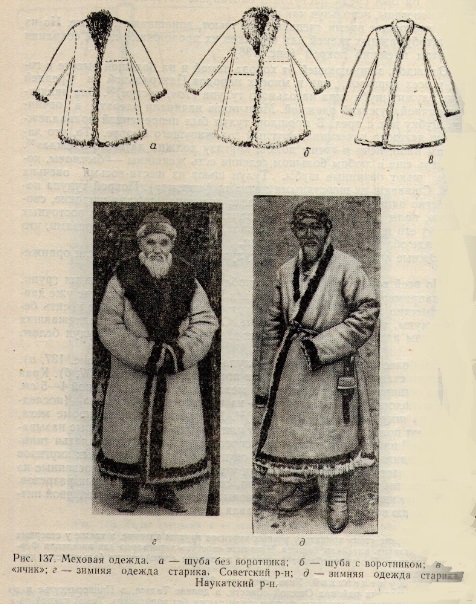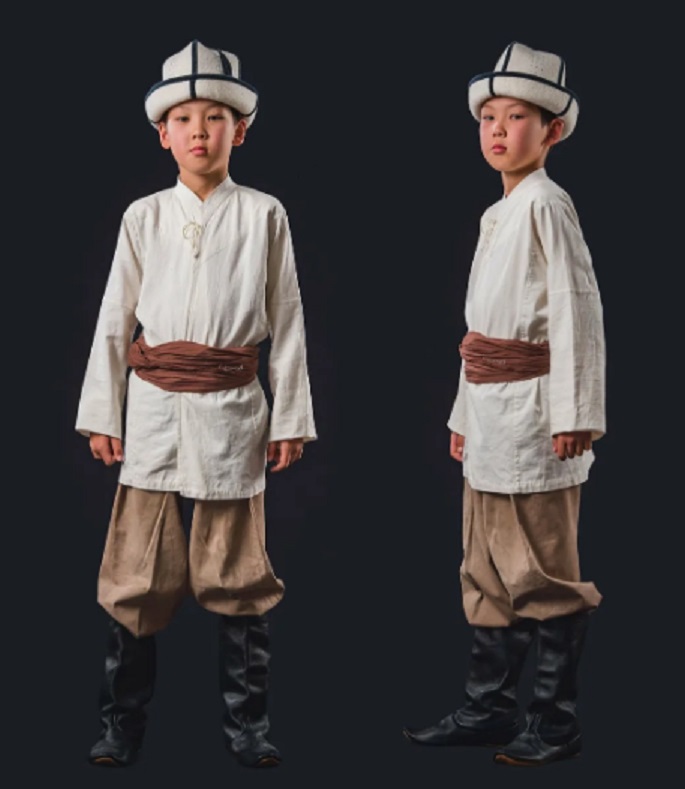The clothing that protects against the cold in winter and at high altitudes in the mountains for all Kyrgyz people, as well as for many peoples of Central and Middle Asia, is the fur coat of the type known as nagolny tulup (ton, postun). It is a typical male garment. Boys began to be dressed in sheepskin coats from about the age of three. In the past, the tulup was an essential attribute of every nomad living year-round in a yurt.
“What our stoves and the walls of our houses provide, a Kyrgyz must receive from his clothing.” Even now, in any large village, there are women—bychmachi—who sew sheepskin coats. The tulup is made from six to eight sheep skins. They are sewn together with woolen threads (“shoona”).
The cut of the tulup is universally the same: the shoulders are slightly sloped, the sleeves are wide and loose, the hems widen towards the bottom, and the overlap is deep. Previously, in the eastern regions, it was sewn without side slits, but now it is also made with slits, which is common in the western regions.
Southern Kyrgyz dye the tulup in two colors: white or orange.
Most likely, there were favored colors among tribal groups. For example, in the village of Samarkandek in the Batken region, where the Kipchaks and Avagats have long lived together, the former continue to wear white tulups, while the Avagats wear orange ones. Among the Kyrgyz belonging to the Adigine and Mungush groups, there is a custom to wear tulups of white color.
The oldest form of the tulup is without a collar (see Fig. 137, a). Collars began to be sewn on only recently (see Fig. 137, b).

The edges of the tulup are trimmed with a strip of black fur (bara, kёрpё) 4-5 cm wide. Sometimes the strip is made double—of black and white fur (the latter from goat skin—ak serke). In many regions, in addition to fur, strips of black velvet or black satin are sewn on, which are called kyobёo or manat bara.
This method of decorating outer garments is typical for Mongols and was also practiced by the Altai people. Among the southern Kyrgyz of the western part, it is customary, as among the Uzbeks, to sew triangles cut from black fabric onto the shoulders, back, and at the bottom of the side slits. Some Kyrgyz embroidered tulups for young men with silk thread along the edge of the upper hem and on the sleeves with the “zhёrmёmё” stitch.
Sometimes, the sheepskin tulup is covered (as with northern Kyrgyz) with a dense black fabric, which has become widespread in the eastern part of the Osh region. In more affluent families, winter clothing in the past was a fur coat (ichik), most often covered with cloth, silk, or satin (see Fig. 137, c). Depending on material possibilities, it was made from otter, fox, sheep, or wolf fur, but was worn without a collar. Only the edges of the hem, collar, and sleeves were trimmed with a strip of fur 2-3 cm wide. The cut of the coat is wide at the bottom, with set-in sleeves. This type of coat is considered traditional clothing. Older examples were characterized by very long and narrow sleeves, which mainly distinguished this clothing from the tulup covered with fabric. The “ichik” was considered festive clothing among the Kyrgyz and was worn rarely. It is said that the “ichik” spent more time in the chest than on the shoulders. In the past, this clothing was part of the dowry and was wedding attire for both men and women. Now such coats are neither worn nor sewn. The “ichik” resembles Altai winter women's clothing.
Men's outerwear of the Kyrgyz - halat















































